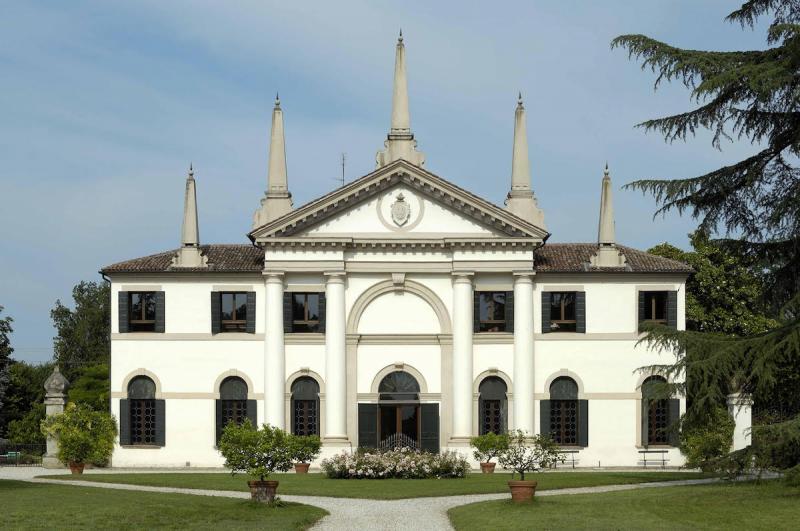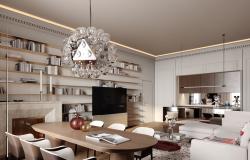In my apartment in the Veneto I have a framed poster with photographs of the lovely villas in and around Padua, where Palladio was born. Over the years I’ve tried to see them all, not an easy project when some of them can only be visited by prior arrangement in a group of 15 people. Mostly they’re ticked off, but recently I’ve found a new challenge. The Veneto is an area full of villas, and my poster shows those which are better known, but merely the tip of the iceberg. There are many more equally beautiful villas out there, and it is a particular pleasure to discover them. What follows is a very exciting new discovery.
When you drive through the small agricultural villages of the Veneto south of Venice it all seems a little flat and uninteresting. Yet look again. This is an area rich in history and there are hidden gems to be discovered.
If you blink whilst you’re driving through the tiny village of Vanzo, near the Monselice exit of the A13 autostrada, you’ll miss a pair of tall wrought iron gates at the beginning of an avenue of lime trees. At the other end of the avenue is one of the loveliest yet unknown villas of the Veneto, still lived in by the same family rather than the empty faded museums which many villas have become.
Finding villas in Italy can often be rather confusing because they are usually known by the name of the family who owns them. The confusion arises when over the centuries villas have changed hands many times, each time adopting the current owner’s name. In this case, though, it is known as the Villa Giustiniani and always has been.
The Giustiniani are a noble Venetian family, descended from not one but two doges: Giusiniano Partecipazio, Doge from 819-828, and Marcantonio Giustiniani from1684-1688. The present occupants of the Palladian part of the villa, Count Lorenzo Giustiniani and his wife N.D. (Nobil Donna) Roberta Soranzo are the responsible stewards of a heritage site. But what do you do when a venerable old building needs constant maintenance? Moving elsewhere would be unthinkable.
We discussed the difficulties over a delicious lunch in the rustic kitchen, once the cantina(wine store) and now a characterful space with a 16thcentury tiled floor and octagonal columns of toasted brick. There’s a balance to be struck between maintaining a private home and opening it to the public: the first makes it more attractive, but the more people visit, the more the place becomes just another tourist venue. The answer is, the personal touch.
Obviously, Roberta and Lorenzo are proud of their heritage and keen to share it. They are also both enthusiastic gardeners, in summer up and gardening at 5am before the sun’s heat makes it impossible. What could be better than a personal morning guided tour of house and grounds followed by an aperitivo, or in the afternoon the same personally guided tour followed by cakes and prosecco? In this manner, a tourist becomes more like a guest, or even a friend, and the visit feels not only special but original.

What will the tour include? First, the villa, which is much older than the impression given by the white façade. This Palladian frontage was remodelled by Baldassare Longhena (the architect of the Salute Church on the Grand Canal in Venice) in 1674. The pediment is particularly striking with its five obelisks on the roof, signifying the family of a Doge. (A curiosity is that the two outer columns are also chimneys, still in use.)
The interior is stunning. The main rooms facing the garden are frescoed, with high ceilings and views over the garden. The ‘winter garden room’ is particularly striking. You stand in a painted loggia with columns and exotic vegetation on all sides, but best of all, this loggia replicates the distant view from the villa itself, of conical hills – unmistakably the Colli Euganei, a group of extinct volcanoes 10 miles away.

The Countess, Roberta, has a vast collection of porcelain, some from local potteries and others from elsewhere. There is a collection of teapots, unusual modern china decorated with asparagus, and from the nearby town of Este, two distinctive collections with a vegetable theme. On the kitchen wall hang 18 white plates (once there were 20) of extremely realistic fruit and vegetables, and on the hearth in front of the large stone fireplace are lots of shapely pottery pumpkins, some very old indeed.
It isn’t just the family who find the old kitchen cosy and inviting. Just outside the door is a pipe which retains heat. They often find a long black snake curled around it in the mornings, but it’s a harmless resident and just slides away.

Family photographs add a very personal touch. There is a handsome photo of Lorenzo’s grandmother, Princess Beatrice Corsini in a silver frame amongst recent photos of family weddings and grandchildren.

On the walls is a whole series of portraits of the Giustiniani family, and Lorenzo has many interesting stories about his ancestors. Smiling proudly as he peers over his glasses, he begins a well-rehearsed tale, reminding us that maintaining the family line was important to the nobility of Venice. In 1173 Venice was at war with Greece and all the Giustiniani family were killed apart from Nicolò who was a monk. He was given special permission to marry Anna, the daughter of a doge and they produced 12 children. When the last son was 16 the father returned to the monastery, and the mother to a convent. They are venerated as Beato Nicolò and Beata Anna.
Saint Lorenzo Giustiniani after whom Lorenzo is named, was the first Archbishop of Venice. He died in 1456.
Doge Marcantonio Giustiniani never married and therefore had no direct descendants, so the family line continued via the Doge’s brother Girolamo who commissioned the villa’s new Palladian frontage by Longhena.
A more recent Count Girolamo, Lorenzo’s father, was a member of the Guardia Nobile of the Pope, Saint Pio X in 1912, and the present Count Lorenzo adds a further distinction to the family line as the Delegate for Veneto of the Knights of the Sovereign Military Order of Saint John of Jerusalem, Rhodes and Malta.
Like this article? Don't miss "Rovigo: A Small Town in the Veneto Which Punches Above Its Weight!"
After a coffee with the ancestors looking down on us, we moved into the garden, 30,000 square meters of colour, light and shade. The grand avenue of lime trees leading to the main entrance is on a majestic scale all year round, but comes into its own at the beginning of June when the blossom appears, giving an almost tactile sensation of walking through a wall of honey vapour. To either side are the sweeping flower beds, and to the right, the orto (kitchen garden) and the orchard, which includes 100 lemon trees in weathered terracotta pots..
The garden has seasonal delights even in winter, but in spring there are collections of bulbs: colourful varieties of tulips, lilies, hyacinths, peonies etc. The glorious summer rose gardens are perhaps the highlight of the annual displays, with over 300 traditional old varieties including ramblers, tea roses, damascene and multiflora which originally came from the best growers in Italy, England, France and Germany. Under the lime trees, rare varieties of cyclamen bloom in autumn, as well as anemones, asters, verbena, and many more.

The Count and Countess are very knowledgeable about their plants: a visitor with a passion for horticulture would be in seventh heaven.
The title of this piece indicates that the same family has lived in this villa ever since its construction. However, during World War 11 part of the villa became the German Military head quarters for the area, though some family members remained there as housekeepers and protectors. Fortunately, it remained unchanged.
So over the past 400 years this home has stood calmly on its own land facing the world, like Venice, with serenity. What family motto could be more appropriate than Fortiter sed Soaviter, which can be translated as ‘Strongly but Gently’. These two qualities are doubtless the reason this lovely villa has survived intact, and will continue to delight generations to come.
How to visit
The Villa Giustiniani can be visited by individuals or groups.
Contact: info@villavanzo.com or 0039 0429 719202
Prices: €8 pp gardens only, €10 pp house and villa. The gardens are available for visits between April 1st and October 31st.










